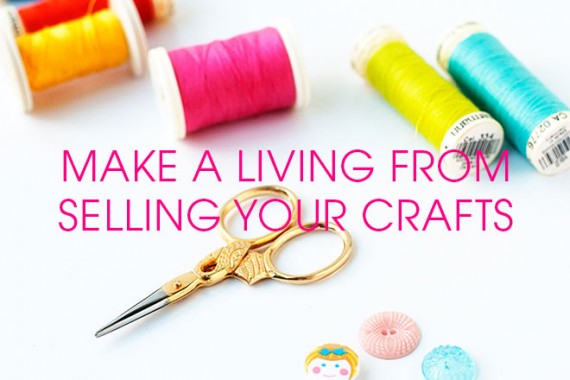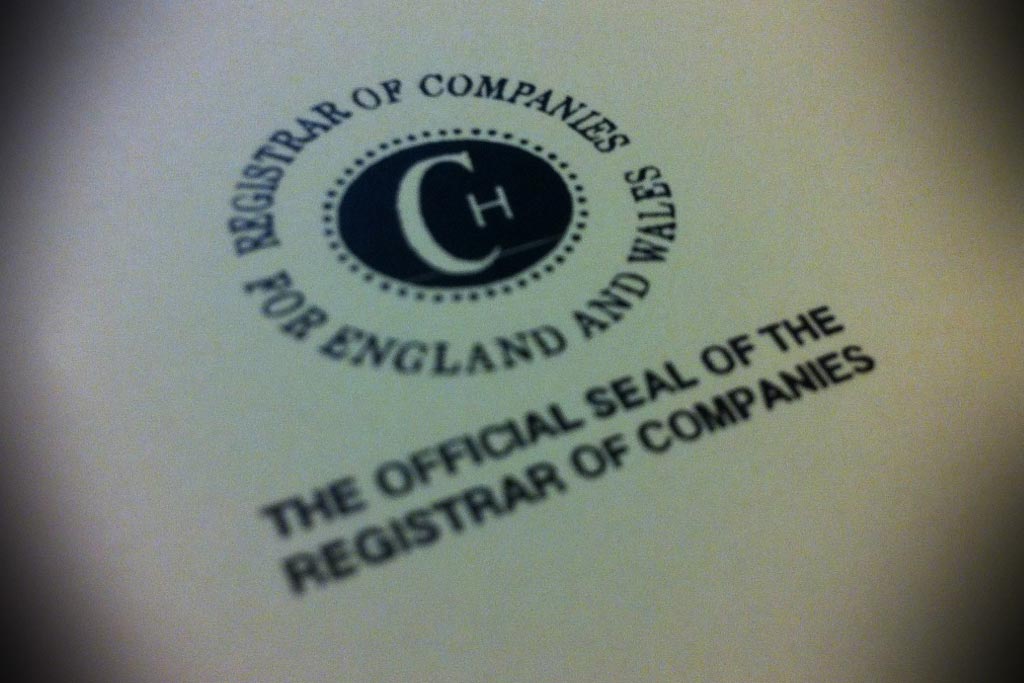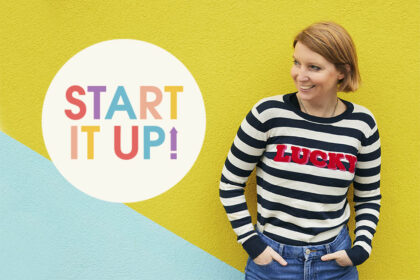How to make a living from selling your crafts – a complete guide
Are you struggling to sell products that you make online or in shops? Or want to start but don’t know where to begin? Learn how one mum has built a successful business from selling her handmade lampshades.
One of the first ever inspiring mums we interviewed for Talented Ladies Club was our friend Miranda Law – the extremely talented lady behind Swee Mei lampshades.
When we interviewed Miranda she was just starting out in business, trying to find the best places to sell her handmade lampshades, and people to buy them. 18 months on, she has more orders than she can cope with, and earns a good living from her work.
Over the intervening months she’s experimented with pretty much all the main online selling platforms – with good and less positive results. And we know how inspiring stories like Miranda’s are. Like her you can craft party accessories, costumes and can create an income for yourself.
So we asked her if she’d share her experiences with us, to help other designer/makers and online retailers earn an income online (and in shops) too.
If you’re looking to make a living from selling your own art, there are several steps you can take to ensure your success, including developing your own unique style, building a strong brand identity, and using print-on-demand services like Gelato to help you create and sell your art products online. Read on for Miranda’s advice.
Love to start a craft business but stuck on an idea? Get our Business Idea Kit for just £19
My guide to selling online
So it’s been about a year and a half since I first started selling my handmade lampshades and was first featured on the Talented Ladies Club website.
It’s been a fantastic start to my business and I’ve learnt a lot in that time so I thought I’d share with you some of my experiences of selling through various different channels – some with great success, some not so much.
I appreciate that some of you who sell will have had vastly different experiences but this is how things have worked out for my business, Swee Mei Lampshades.
Selling on Etsy
As you probably already know, Etsy is an online market place for handmade items, vintage goods and craft supplies. It’s the biggest and best known site of its kind and seemed the obvious place to start for me.
As an American site it reaches a huge audience, which is great if you’re prepared to ship over the pond too (I wasn’t). There are somewhere in the region of a million sellers on Etsy and over 30 million registered customers. That’s a lot.
It’s easy to set up
Anyone can open an Etsy shop so quality can vary hugely. There are some excellent sellers on there and there are are some downright bizarre items too. Lots of OOAK (One of a Kind, and probably just as well) items among bigger, more established shops.
The shop itself is easy to set up and you can give your customers options to click on regarding size, colour etc. There is no joining fee – you pay a small charge to list an item (20 cents for four months or until it is sold) and 3.5% of the price if and when it does sell.
Being such a huge site is a double-edged sword. Although you can potentially, as a seller, reach a massive target audience, you can also get lost in a great sea of crafting genius, handmade mediocrity and worse.
Think carefully about your listings
Think carefully when you write your listings and titles, about SEO (Search Engine Optimisation), keywords, the order of those magic words and what your potential customers will be typing into the search box. (This goes for all online selling and there are many articles out there that will help you to figure this all out.)
Listing/re-listing frequently will help, as will getting involved with the Etsy community. There are teams you can join, who will be sellers in your area or who sell the same kind of items as you, and the community forums are a great source of advice, support and a fantastic way to network. Other Etsy sellers put together ‘treasuries’ – themed wish-lists if you like – and to get your item featured in one guarantees a lot more views to your shop.
I don’t really speak from experience here. I didn’t throw myself into it and had a grand total of one sale on Etsy in the few months I was on it. And that was from a friend of a friend who I suspect would have bought from any site.
Selling on Creative Fabrica
Another popular option is Creative Fabrica, a marketplace for crafters and designers. The goal of Creative Fabrica goal is simple: to provide exceptional resources for your projects at a fair price.
This fast scaling start-up from Amsterdam wants to change the way people consume digital assets. They consider each font and craft is a little piece of art and believe that art should be made available to everyone.
You can earn recurring monthly revenue on the site just by participating with your items. Your earnings will increase over time as more and more people join the platform. Whenever you create and release a new item you will automatically start earning revenue for that element.
Selling on Folksy
I love Folksy and it was good to me when I first started up. It’s a British site, lauded as our equivalent to Etsy but much, much smaller and not as well known. There are around 6,000 sellers on Folksy at the moment and a quarter of a million visitors a month.
Again, it’s for handmade, vintage and craft supplies. Anyone can sell, there is no joining fee and it’s 15p to list an item for four months and 6% per sale. Great if you don’t have a huge number of products, but if you do, or would like to re-list your items more frequently, you can become a Folksy Plus seller for £45 a year.
You’ll still have to pay the 6% on sales but there are no listing fees. The advantage to listing/re-listing frequently is that your items will have a higher search ranking. A very good thing.
Selling on your own e-commerce site
Selling on your own site is a quite different to Etsy and Folsky. By setting up your own storefront and sourcing products from suppliers, you’re establishing your very own e-commerce business.
Many budding entrepreneurs have had great success through private-label products. These are products created by third-party manufacturers under your unique brand name. This type of setup provides the most control over your products, profit margins and brand as a whole.
You also decide how to show your crafts. You can post photos or shoot detailed video guides on how you make different crafts. Or if you only have small videos, then you can merge videos online and get one full video that you will add to your site. When you have your own website, the options for promoting your products are almost limitless.
Courses like the Amazon Selling Machine teach people how they can start their own private-label e-commerce business and have helped create many successful online store success stories.
Get involved with seller forums
As with Etsy there are seller forums with good advice and support from others. Well worth getting involved in as I suspect a fair few of my sales came from other Folksy sellers.
The site is very pretty, easy to use and set up and the quality of items available is, generally speaking, quite high. Each listing is for that item only, you can’t give any clickable options for size or colour, which is a bit of a pain but the way round this is to offer choices in your listing text and then ask the customer to let you know their choices at checkout. Or you may have to set up a new listing for them if the price point is different. Not really ideal but workable.
I found Folksy to be a great place to sell as I was starting up. Sales trickled in slowly but steadily and it’s a good place to direct people to if you don’t already have your own e-commerce website.
You need to work at getting your shop seen
With both Etsy and Folksy, you have to work at getting your shop seen and achieving sales – you can’t just sit back and hope for the best. Linking to your shops from a Facebook page, Twitter, Pinterest and Instagram accounts will increase viewings and should in turn increase your sales.
If you’re lucky enough to be featured on the front page or in a ‘gift guide’, all the better. These are collections curated by Pinterest users and Folksy HQ and guarantee lots of views.
I often see people ask whether they should sell with Etsy or Folksy. I say do both. Why wouldn’t you? You’ve taken the photos and written the descriptions and that’s the most time consuming part. Listing items is a fairly quick process after that. And at 15-20p per item, it won’t break the bank.
Selling through an event
Of the many potential benefits offered by events, many people believe it is one of the best ways to help prospects and customers discover you. Whether it is online or offline, by hosting an event, you can get the chance to interact with like-minded people who are interested in buying crafts.
So if you want to boost your customer outreach efforts, selling through an event could be a good option. You can sell crafts as well as sell tickets online for your event and earn more profit.
Before the event you will need to plan the venue, timing, staffing, marketing, decoration, ticket pricing and other enhancements you want to add. This will require upfront cost, so if you don’t have the liquidity to front the cost, use an easy finance option such as an equity loan until after you have the profits from your event. Research “title loans in Oregon” or similar for your location to find out more.
Use an event management platform
Do your research and find well-known event management platforms you can use to host your online event. From designing an event page with all the information vendors and attendees will need and creating different ticket types, to selling event tickets, managing your event and maintaining post-event communication, you can create everything seamlessly using event management software. Many of these tasks would be incredibly time-consuming if you were to try to do them manually.
In your event description, try to add every important or useful detail, including the event name, time, and address, as well as a list of items (maybe even with a price) that will be available for sale. If you have organised any similar events in the past, add pictures or YouTube links as a reference.
If you want to host a virtual event, you can use a virtual event platform to sell your craft all around the world. A secure and scalable platform will help host your event without an issue with virtual hosting or payment procedures.
Selling through Facebook
I’ve not got a Facebook shop but I do have a business page. It’s an amazing way to reach an audience and get your work seen. I’ve found it to be friendly, supportive and also a good way to get those all important sales.
Ask all your friends to ‘like’ your page (some of them will). They’ll make the odd comment, their friends will see it and hopefully ‘like’ your page too and on it goes.
Use giveaways to attract likers
A giveaway or competition is easy to set up (read Facebook’s rules first) and will bring in lots of new likers. Follow other pages that interest you or are relevant, post engaging content, link, share, comment and others will do the same for you. But only do these things if you mean it, not just so that others reciprocate.
There are some fantastic pages like British Crafters who do great work in sharing others’ makes and it’s well worth getting involved with them.
Your page should reflect you, your brand and your tastes. Your likers will get to know you a little and you build customer confidence in your business. Facebook is usually my first port of call when I want to share a new product, some good news or want to run ideas by someone.
Put some personality into your page
I ‘met’ many lovely and talented people on there and it’s by far the most social platform. But don’t get carried away. Although it’s great to put some personality into your page, the rest of the world doesn’t need to know that your whole family have a stomach bug or that you’re really annoyed with your partner. Keep it positive and professional.
There have been a lot of complaints recently about Facebook changing its algorithms so posts are not being seen by as many people. This is because Facebook would like you to pay to get your posts seen. I’ve not noticed a huge change but the more you interact , the more you’ll be seen.
I did pay for an ad once. It’s quite cheap, your ad goes to a targeted audience and I gained a fair few new likes and lots of views. Whether they translated into sales or not, I’m not sure. I have a link to my website on there so it’s hard to tell. I’ve made many sales through Facebook though, that much I do know.
Selling through your own website
I set up my own website a little while after I’d started selling. I designed it myself on Weebly. I’m no techie and I’d never done anything like that before, but it was really simple and straightforward.
My site is pretty basic but it does everything that I need it to. At first I didn’t have it set up for e-commerce, I just had a page that linked directly to my Folksy shop, which worked just fine but obviously it looks far more professional to have a proper shop page, as I do now.
One thing that is important for SEO is the user experience of your website. Make sure it’s mobile optimised and loads quickly. If not, look for ways to speed up your website. It is important to make sure your website looks credible, or your visitors won’t trust you enough to buy. This website credibility checklist will tell you everything you need to keep in mind.
Read up on SEO
Talking of SEO, it takes a while to become established and increase your ranking or even appear in searches but is well worth doing – just think of the money you’ll save from no commission fees on your sales!
Read up on SEO (you’ll find some helpful advice on writing SEO copy for your website here), consider your content carefully and remember to use your keywords – and not just in your text. Your photos should be tagged too as you’ll want to show up in image searches as well. A blog (updated frequently, of course!) and sharing links will also help up your search rankings.
I know that many customers prefer to buy directly from the seller rather than line the pockets of a middle-man. They’ll see your work elsewhere, Google your brand and then buy directly from you. Great news for you if you have a website. (But equally you’ll find that others will feel more secure buying via a more established online store, so it’s good to have both.)
Set up Google Analytics
Link your website to Google Analytics and you’ll be able to see how many views you’re getting, from whom, what they’re looking at, how they found you and much more – all very useful information.
It’s a little baffling at first (well for me it was) and I only ever look at the basic information, but it can be strangely addictive to see, in real time, how many people are looking at something you’ve just posted.
The last few months have seen my website sales growing and growing and I’m always on the first page of Google for a ‘handmade lampshade’ search, although I’m pretty sure it’s only me that ever Googles that. Anyway, do it. Set up a website. It’s really important and you’ll be taken more seriously by buyers, press etc.
Selling on Not on the High Street
This seems to be the platform that most people want to sell on, and for good reason. They only accept a very small percentage of applications to sell with them so the quality of items is high.
There is a one-off joining fee, around £200, and they take 25% (a total of 30% with VAT) commission on sales. It sounds a lot but if you were selling wholesale to a shop, it would likely be around 50% and Not On the High Street has a huge following, strong marketing and a great reputation, so your products will be seen by a vast audience.
Put up your prices if you need to
This is by far and away the place where I sell the most lampshades. It’s a nice looking website with lots of choice and customers are confident to buy on there. I’ve put my prices up since selling with Not on the High Street (you kind of have to!) and have found that customers are more than happy to pay them.
It takes a little while to set up your shop. It’s slightly more complex than either Folksy or Etsy, but there is a great deal of support available from Not on the High Street staff who will help you every step of the way if you so wish.
Once you’ve set up your shop, it will be reviewed and suggestions made for changes or improvements if necessary. I got my first sale the day after my shop went live and it’s only got better. The more you sell, the more you’ll be seen, and the more you’ll sell.
It’s not an ideal site for one-of-a-kind items as listing takes longer and they’ll be harder to find in searches, having not been previously sold.
It’s a very big site and the search function isn’t great. Enter ‘blue lampshade’ and you’ll be presented with items that are blue, items that are lampshades and items that are neither. But they’re working on it.
Not on the High Street have a big budget for marketing and advertising and good contacts with the press. I’ve had my work featured in Stella Magazine (the Telegraph) and I’ve been asked to feature in the upcoming Christmas TV campaign, as well as a few other items in the press. So that joining fee and commission are well worth it. You don’t have to work so hard at getting sales here – they do the work for you.
You will be limited as to where else you can sell the exact same products (they want to stay true to that ‘not on the high street’ claim) but Etsy, Folksy, EBay, your own website and local shops are fine. If you need cash upfront to start your business, the average title loan amount can cover it. A title loan can allow you to access up to 75% of your vehicle’s value and turn it into cash.
Make sure you have great photos
Make sure you have great product photos. What might be acceptable on Etsy or Folksy may look a little homespun on Not on the High Street. There is a very high standard of presentation and even fantastic products won’t sell if not photographed properly.
Again, there is a lot of info out there on taking good product shots. There are workshops or you could pay a photographer for a private lesson/shoot, which is well worth it. (I will admit to one or two of my photos being taken on my iPhone though.)
Selling at craft fairs and markets
I did quite a few fairs when I first started up Swee Mei. They can be good fun, sociable and a great way to judge interest in your products. But only if you’re at the right sort of fair.
You don’t want to be trying to flog your amazing hand-knitted, organic, tie-dyed boob tubes to some pensioners who have wandered in off the street looking for nice jam. So do your research and think carefully about location and also look into who else will be selling there. Are you compatible?
Find a market or fair that is a fit with your products and sell there regularly. People will know where to find you when they finally realise their need for that boob tube.
Bring lots of business cards
Don’t be disheartened if you don’t sell much on the day. It’s about getting your brand known as much as anything else. Have lots of business cards available and people may well come to you at a later date. This happened to me – people loved the shades but not many bought on the day, lampshades not really being an impulse purchase. However they did visit my website to buy once they’d had a good think about it.
Try to create an eye catching display and it helps if you can have something to be working on throughout the day. Customers are interested in how things are made. Oh, and SMILE. There’s nothing more off-putting than a stall-holder sitting there with a face like thunder because they’ve not had a good day.
I stopped doing craft fairs for a number of reasons – I didn’t like giving up my weekends, childcare was an issue, large numbers of lampshades are a pain in the bum to transport safely, and although I made a few sales I didn’t feel the end justified the means.
I can’t say I stuck with it long enough to make fair judgement, to be honest, but it wasn’t really for me. If you sell smaller, mid-priced items you’ll probably have more success than I did.
Selling through shops
I guess that having lots of shops stock your products is probably the dream. In fact some makers choose to sell wholesale exclusively. Obviously you stand to sell much more if your products are in many outlets, where they can be looked at, touched and picked up, as many people like to see things in the flesh before they buy.
But bear in mind that most retailers want to pay you around 50% of the retail price. This may seem a lot when it’s you that’s buying the materials and making the items, but retailers have many overheads to cover, including premises, utilities, staffing, advertising etc.
You might be able to produce your items at a smaller cost if you’re fulfilling big orders or you may just be happy to make less profit but on more sales. However, if the 50% wholesale price doesn’t work for you, consider selling on a sale or return basis for a smaller percentage.
Typically, the retailer will take 20-30% of the retail price for sale or return. Make sure you are both clear on how long the items will be stocked for initially and who is responsible for delivery costs – normally you’re responsible for delivery and they’re responsible for return costs.
Drop-shipping is a great way to sell too. Retailers advertise your products and take orders for you, but you’re responsible for delivery.
Have separate agreements for different shops
You may want to have separate agreements with different shops depending on how much you want to be stocked by them. If Liberty come a knockin’ that 50% may not seem to harsh, so judge each offer on its merits.
I’ve been asked by a lot of shops about wholesale but I’m currently only working with a couple of bricks-and-mortar retailers. When I started making lampshades, I set my prices at a level that was right for me selling directly to customers. I’ve put them up a little since then, but unless I cut my manufacturing costs and/or raise my prices again, the numbers for selling wholesale don’t really work for me.
It’s something that I would like to get more into in the future but I’m being kept pretty busy at the moment through other sales channels so it’s not top of my list.
I’ve learned so much along the way
So that’s how it’s been for me. I still see myself very much as a beginner in this whole business, but what a great start it’s been! What began as an idea to make some pin money alongside my ‘normal’ job has taken over and is earning me far more than my other work.
Along the way I’ve learnt so much, not had any major disasters and, most of all, enjoyed every minute of it. The freedom of working from home and choosing my own hours is the biggest bonus. I generally start work in the early hours of the morning and can have done half a day’s work before the children are even awake.
So if you think you have a great idea or an original product, just go for it. Do your research, work hard and make it happen. You (hopefully) won’t regret it.
You can find out more about Miranda and see her range of handmade lampshades on the Swee Mei website.
Photo credit: Love FromGinger










